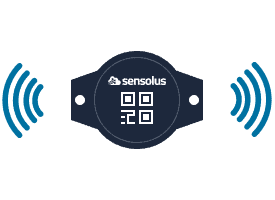There’s a lot of buzz around Bluetooth Low Energy (BLE) these days and for good reason. Its ability to help devices communicate with each other more efficiently makes it perfect for supply chain management.
In this article, we’ll understand exactly what BLE is, explore how BLE is being used in supply chain management, and what benefits it can offer. We’ll also take a look at some of the key advantages and challenges associated with using BLE in this setting.
Keep reading to learn more!
What is Bluetooth and BLE?
Bluetooth is a wireless short-range communications technology, mainly designed for communicating over short distances. The devices need to be within approximately a hundred meters. One key reason for the incredible success of Bluetooth technology is the tremendous flexibility it provides developers. Offering two radio options, Bluetooth technology provides developers with a versatile set of full-stack, fit-for-purpose solutions to meet the needs for wireless connectivity.
Though Bluetooth has been around for two decades, its latest version, Bluetooth low energy (BLE) is transforming geolocation. BLE is designed with similar features as Bluetooth but with a focus on low power. As a result, it is not as fast as Bluetooth and is not suitable for transferring large files, but it’s ideal for moving small amounts of data with minimal power consumption.
BLE has made it possible for a wide range of small IoT devices, such as sensors and tags, to communicate despite limited batteries. Most smartphones and devices today are equipped with Bluetooth capability.
The benefits of using BLE for geolocation
BLE uses very little energy compared to other wireless technologies and can operate for extended periods of time on a single battery charge.
BLE’s power-saving abilities make it an ideal candidate for use cases in supply chain management and logistics. For example, BLE tracking tags can be placed on inventory items to track their location throughout the supply chain. This information can then be used to optimize the supply chain and improve logistics efficiency.
In addition, BLE can be used to track the condition of inventory items, such as temperature or humidity. This information can be used to ensure that goods are maintained in the proper conditions and prevent spoilage or damage.
The uses of Bluetooth low energy in supply chain management are numerous and varied. With its low power consumption and robust feature set, BLE is well-suited for a wide range of use cases in this domain. As technology continues to evolve, we can expect to see even more innovative uses of BLE in supply chain management and logistics.
Differences between Bluetooth Classic and BLE:
- BLE uses about 1/10 of the energy Bluetooth devices use. BLE achieves this by constantly being in ‘sleep mode’ until a connection is initiated.
- If devices need a more extended range to operate, they should be using Bluetooth, but BLE should be used if they need to run for longer periods over shorter distances.
- BLE excels at transmitting small and infrequent data packets using low amounts of power and low latency, while Bluetooth excels at continuously transferring large amounts of data.
- Bluetooth connection times are ~100ms, while BLE connection times are only a few mS — making connections to BLE much faster than standard Bluetooth devices.
- BLE devices can connect with a larger number of other devices, compared to standard Bluetooth.
How does BLE work?
The advantages of Bluetooth Low Energy and BLE beacons are that there is no interaction required with existing IT infrastructure for communication. This geolocation technology works accurately both outdoors and indoors.
BLE beacons provide both outdoor & indoor asset tracking. The more BLE beacons you install indoors, the more accurate the positioning of your asset will be.
There are two options to localize a tracking device via BLE:
- Geobeacon (fixed-location BLE beacon): a BLE location marker on a fixed location advertises its position over BLE. The tracking device receives this data and reports the position to the end-user
- BLE gateway: the tracking device announces its presence via BLE to a BLE gateway on a fixed location. The BLE gateway identifies the tracking device and reports its position to the end-user
About fixed-location BLE beacons (Geobeacons)
Geobeacons act as location markers. These devices emit a BLE signal that tracking devices use to identify their location. So when you install beacons on known locations, the beacon will broadcast its identifier. The tracking device nearby identifies the broadcaster, the beacon, and uses this to determine its position.
With beacons, there is no interaction required with the existing IT infrastructure for communication. The beacon itself is the minimal infrastructure that has to be installed. A battery-powered beacon is much cheaper than installing wires in industrial zones, for which you might need to shut down processes and perform security checks.
The battery life is guaranteed for many years. They require very low energy and can easily be integrated into your existing logistics infrastructure. A disadvantage is that it’s a little less accurate than GPS, and it requires minimal infrastructure where GPS requires none.
About BLE Gateways
An alternative approach to locating a BLE device is working with BLE gateways. Gateways are installed on fixed locations and act as a location marker. These devices are used to localize tracking devices that are not (necessarily) connected to the Internet. The tracking device transmits a BLE signal which is received by the gateway. The gateway will forward the unique identifier of the transmitting device to the cloud allowing it to be localized.
What are the uses of BLE?
Bluetooth low energy is used for many different applications but is best suited for uses where other location tracking technologies are limited, such as in indoor environments where GPS systems cannot accurately assess the locations of people, objects, and other assets.
The primary use case for BLE is for indoor positioning systems. Indoor positioning systems are implemented to track the location of people and assets, promote products, share information, and help people’s navigation.
- Asset tracking: BLE is useful for tracking the general locations of people, equipment, and goods within indoor environments. Many manufacturing and warehousing facilities use BLE to track assets within them.
- Production promotion: Companies use BLE to send push notifications to their users’ mobile devices when near their stores.
- Sharing information: BLE enables sharing information with people at a particular location about points of interest (POI) within their environment.
- Navigation: BLE is also used to help people find their desired destinations faster. This is generally enabled by people installing a specific mobile application to allow communication between their devices and BLE beacons in the area.
Pros and cons of BLE technology
Every technology has its benefits and limitations, and BLE is no exception. BLE localization accuracy relies on determining the distance to a fixed marker. There are different approaches. The device can take over the location of the closest marker, estimate distances to all markers it can reach, and do triangulation to determine a position. At Sensolus, we use a single BLE beacon. There are also different techniques to determine the distance between two devices over BLE. The simplest is using the signal strength of the received signal, but measuring angles or calculating flight time is also possible. However, using multiple nodes based on received signal strength has low accuracy, and using angles requires complex hardware.
BLE achieves optimized and low power consumption by keeping the radio off as much as possible and sending small amounts of data at low transfer speeds. And most importantly, it’s already implemented in most smartphones in the market.
BLE (and Bluetooth, in general) was designed for short-range applications, and hence its range of operation is limited. There are a few factors that limit the range of BLE:
- BLE operates in the 2.4 GHz ISM spectrum, which is greatly affected by obstacles that exist all around us, such as metal objects, walls, and water (especially human bodies)
- Performance and design of the antenna of the BLE device.
- The physical enclosure of the device.
- Device orientation.
Bluetooth Low Energy in short:
Pros (+)
- Accurate indoor/outdoor (depending on infrastructure)
- Low energy use (1/15th of GPS)
- The minimal wireless infrastructure required
Cons (-)
- Although minimal it still requires installing infrastructure
- Limited range
Geobacon localization: how do we use it at Sensolus?

The tracker can receive a signal of a geobeacon when it’s nearby. If the location of the geobeacon is known, a location will be shown on the map. Geobeacons can be placed both indoors and outdoors but they’re ideal for indoor tracking needs.
